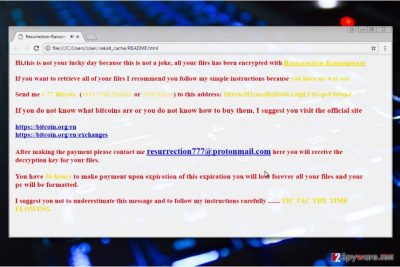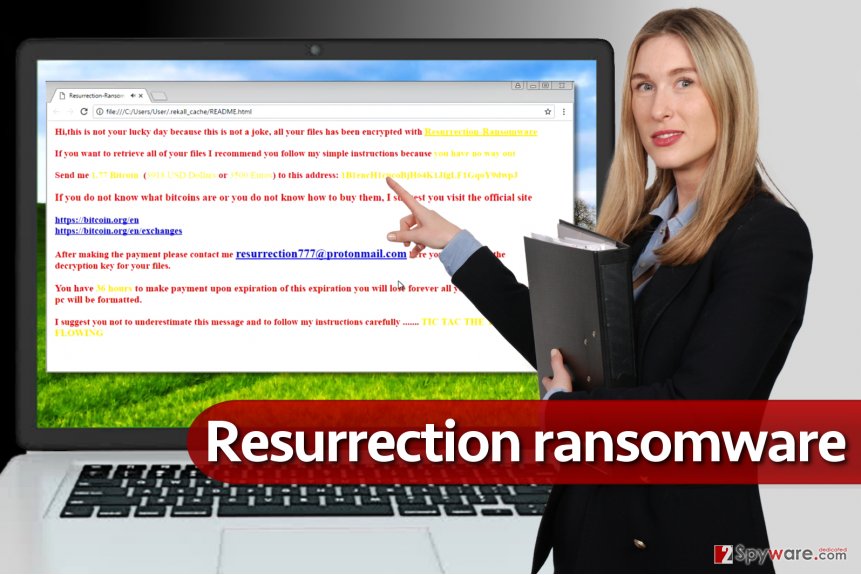Resurrection ransomware / virus (Recovery Instructions Included) - Virus Removal Guide
Resurrection virus Removal Guide
What is Resurrection ransomware virus?
Resurrection ransomware seizes victim’s files to demand a ransom
Resurrection ransomware is a malicious computer virus that is created by amateur programmers that used pieces of HiddenTear ransomware source[1]. Once installed, it encrypts victims files using AES-256 cryptography algorithm, adding .(random).resurrection file extension to the name of every affected file. Then the program launches a ransom note that is called README.html, which opens via a web browser. It demands to pay a ransom and then writing to resurrection777@protonmail.com to receive a decryption key. The ransomware says: “Hi,this is not your lucky day because this is not a joke, all your files have been encrypted with Resurrection-ransomware. If you want to retrieve all of your files I recommend you follow my simple instructions because you have no way out.” The threatening greeting is followed by a demand to pay 1.77 Bitcoin to provided Bitcoin address[2]. Such amount of Bitcoins equals to 4568.30 USD (checked on June 2, 2017), although the ransom note says it’s around 3918 USD or 3500 Euros. The message from cybercriminals also says that the payment must be completed within 36 hours; otherwise, the virus is going to format computer’s hard drives, making all of the victim’s files disappear for good. What is interesting about this virus is that the .html file plays music that reminds Harry Potter soundtrack. The good news is that the detection rate associated with this virus is high which means that having an up-to-date anti-malware software can prevent this virus from infecting your computer. In case your PC is already infected, we suggest you to remove Resurrection using FortectIntego or Malwarebytes. To read reviews of these programs, access Software page on our site.

There is no need to pay the ransom if Resurrection virus attacked your files. It is a decryptable ransomware, and that means you can restore your files without paying the ransom. In case you ever get infected with a more critical ransomware like Cerber, data would stay encrypted forever. However, there are various kinds of malware developers, and part of them are low-level programmers. Mistakes they make give malware analysts a chance to create free decryption tools; however, some professional programmers decide to waste their talent on creating malicious tools. In such case, it is impossible to decrypt files without having the decryption keys that are securely kept in attackers’ servers. However, we never recommend paying the ransom only because scammers give no guarantees regarding data recovery and what is more, paying the ransom to malware developers simply funds their evil projects.

Distribution of ransomware viruses
Almost all ransomware viruses are distributed using the same technique – attackers create fake email accounts and then use them for malicious spam. They create convincing messages and simply add the malicious ransomware-laden file to it (entitled as Invoice.docm, [random digits].zip and similarly). If the victim opens it and activates Macros function or directly launches the file, the malicious virus cripples all target files without an exception. Such ransomware viruses are typically set to target a long list of file extensions, and once they detect files with such extensions on the system, they corrupt them. As a consequence, the victim loses access to his own records all of sudden. The ransomware takes files hostage and demands a ransom to set the data free. The ransomware can also be distributed with the help of Trojans, exploit kits, and sometimes via infected ad networks. To protect yourself from ransomware attacks, we suggest applying several layers of protection – install anti-malware product, create a data backup, and try to avoid suspicious content online.
Resurrection ransomware removal
Ransomware is an especially malicious and dangerous program, therefore we suggest you remove Resurrection virus using professional anti-malware product. If you do not have an anti-spyware or anti-malware product or even antivirus, we suggest installing one right now. You can find the list of suggestions below the article. However, we have also added an in-detail explanation on how to launch the virus removal program because the ransomware can try to prevent you from launching it. After completing Resurrection removal, follow steps provided below to restore your files.
Getting rid of Resurrection virus. Follow these steps
Manual removal using Safe Mode
Remove the malicious program from the system using malware removal tool that you already have or install one of the suggested ones. Before you start the removal procedure, restart your PC using instructions we provided.
Important! →
Manual removal guide might be too complicated for regular computer users. It requires advanced IT knowledge to be performed correctly (if vital system files are removed or damaged, it might result in full Windows compromise), and it also might take hours to complete. Therefore, we highly advise using the automatic method provided above instead.
Step 1. Access Safe Mode with Networking
Manual malware removal should be best performed in the Safe Mode environment.
Windows 7 / Vista / XP
- Click Start > Shutdown > Restart > OK.
- When your computer becomes active, start pressing F8 button (if that does not work, try F2, F12, Del, etc. – it all depends on your motherboard model) multiple times until you see the Advanced Boot Options window.
- Select Safe Mode with Networking from the list.

Windows 10 / Windows 8
- Right-click on Start button and select Settings.

- Scroll down to pick Update & Security.

- On the left side of the window, pick Recovery.
- Now scroll down to find Advanced Startup section.
- Click Restart now.

- Select Troubleshoot.

- Go to Advanced options.

- Select Startup Settings.

- Press Restart.
- Now press 5 or click 5) Enable Safe Mode with Networking.

Step 2. Shut down suspicious processes
Windows Task Manager is a useful tool that shows all the processes running in the background. If malware is running a process, you need to shut it down:
- Press Ctrl + Shift + Esc on your keyboard to open Windows Task Manager.
- Click on More details.

- Scroll down to Background processes section, and look for anything suspicious.
- Right-click and select Open file location.

- Go back to the process, right-click and pick End Task.

- Delete the contents of the malicious folder.
Step 3. Check program Startup
- Press Ctrl + Shift + Esc on your keyboard to open Windows Task Manager.
- Go to Startup tab.
- Right-click on the suspicious program and pick Disable.

Step 4. Delete virus files
Malware-related files can be found in various places within your computer. Here are instructions that could help you find them:
- Type in Disk Cleanup in Windows search and press Enter.

- Select the drive you want to clean (C: is your main drive by default and is likely to be the one that has malicious files in).
- Scroll through the Files to delete list and select the following:
Temporary Internet Files
Downloads
Recycle Bin
Temporary files - Pick Clean up system files.

- You can also look for other malicious files hidden in the following folders (type these entries in Windows Search and press Enter):
%AppData%
%LocalAppData%
%ProgramData%
%WinDir%
After you are finished, reboot the PC in normal mode.
Remove Resurrection using System Restore
-
Step 1: Reboot your computer to Safe Mode with Command Prompt
Windows 7 / Vista / XP- Click Start → Shutdown → Restart → OK.
- When your computer becomes active, start pressing F8 multiple times until you see the Advanced Boot Options window.
-
Select Command Prompt from the list

Windows 10 / Windows 8- Press the Power button at the Windows login screen. Now press and hold Shift, which is on your keyboard, and click Restart..
- Now select Troubleshoot → Advanced options → Startup Settings and finally press Restart.
-
Once your computer becomes active, select Enable Safe Mode with Command Prompt in Startup Settings window.

-
Step 2: Restore your system files and settings
-
Once the Command Prompt window shows up, enter cd restore and click Enter.

-
Now type rstrui.exe and press Enter again..

-
When a new window shows up, click Next and select your restore point that is prior the infiltration of Resurrection. After doing that, click Next.


-
Now click Yes to start system restore.

-
Once the Command Prompt window shows up, enter cd restore and click Enter.
Bonus: Recover your data
Guide which is presented above is supposed to help you remove Resurrection from your computer. To recover your encrypted files, we recommend using a detailed guide prepared by 2-spyware.com security experts.Recover your files from a backup, or, if you do not have one, use one of the following techniques.
If your files are encrypted by Resurrection, you can use several methods to restore them:
Find those Volume Shadow Copies
Volume Shadow Copies can save your files, however, many viruses tend to delete them after encrypting all files. However, you can try to find these copies on your computer using ShadowExplorer software.
- Download Shadow Explorer (http://shadowexplorer.com/);
- Follow a Shadow Explorer Setup Wizard and install this application on your computer;
- Launch the program and go through the drop down menu on the top left corner to select the disk of your encrypted data. Check what folders are there;
- Right-click on the folder you want to restore and select “Export”. You can also select where you want it to be stored.
Restore using tools provided on NoMoreRansom project site
Visit NoMoreRansom website to find a tool that could decrypt .resurrection files.
Finally, you should always think about the protection of crypto-ransomwares. In order to protect your computer from Resurrection and other ransomwares, use a reputable anti-spyware, such as FortectIntego, SpyHunter 5Combo Cleaner or Malwarebytes
How to prevent from getting ransomware
Stream videos without limitations, no matter where you are
There are multiple parties that could find out almost anything about you by checking your online activity. While this is highly unlikely, advertisers and tech companies are constantly tracking you online. The first step to privacy should be a secure browser that focuses on tracker reduction to a minimum.
Even if you employ a secure browser, you will not be able to access websites that are restricted due to local government laws or other reasons. In other words, you may not be able to stream Disney+ or US-based Netflix in some countries. To bypass these restrictions, you can employ a powerful Private Internet Access VPN, which provides dedicated servers for torrenting and streaming, not slowing you down in the process.
Data backups are important – recover your lost files
Ransomware is one of the biggest threats to personal data. Once it is executed on a machine, it launches a sophisticated encryption algorithm that locks all your files, although it does not destroy them. The most common misconception is that anti-malware software can return files to their previous states. This is not true, however, and data remains locked after the malicious payload is deleted.
While regular data backups are the only secure method to recover your files after a ransomware attack, tools such as Data Recovery Pro can also be effective and restore at least some of your lost data.
- ^ Hidden Tear Project: Forbidden Fruit Is the Sweetest. Tripwire State of Security. IT Security News & Blog.
- ^ Brian Fung. What you need to know about bitcoin after the WannaCry ransomware attack. Washington Post. Breaking News, World, US, DC News & Analysis.





















